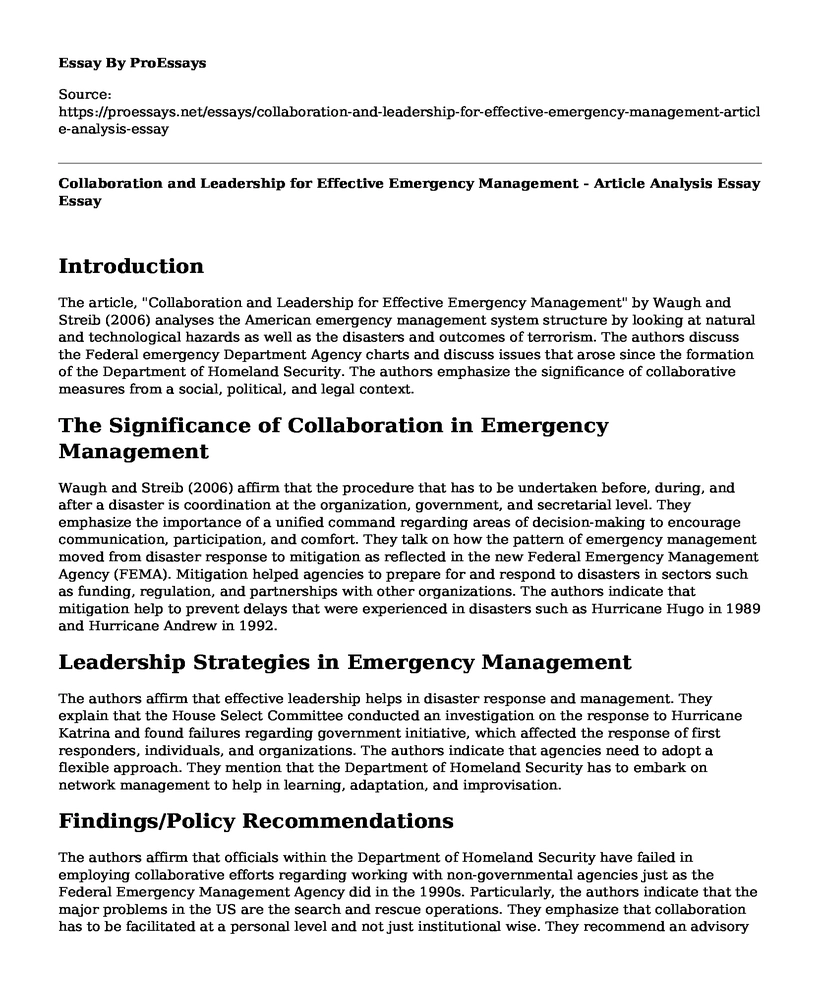Introduction
The article, "Collaboration and Leadership for Effective Emergency Management" by Waugh and Streib (2006) analyses the American emergency management system structure by looking at natural and technological hazards as well as the disasters and outcomes of terrorism. The authors discuss the Federal emergency Department Agency charts and discuss issues that arose since the formation of the Department of Homeland Security. The authors emphasize the significance of collaborative measures from a social, political, and legal context.
The Significance of Collaboration in Emergency Management
Waugh and Streib (2006) affirm that the procedure that has to be undertaken before, during, and after a disaster is coordination at the organization, government, and secretarial level. They emphasize the importance of a unified command regarding areas of decision-making to encourage communication, participation, and comfort. They talk on how the pattern of emergency management moved from disaster response to mitigation as reflected in the new Federal Emergency Management Agency (FEMA). Mitigation helped agencies to prepare for and respond to disasters in sectors such as funding, regulation, and partnerships with other organizations. The authors indicate that mitigation help to prevent delays that were experienced in disasters such as Hurricane Hugo in 1989 and Hurricane Andrew in 1992.
Leadership Strategies in Emergency Management
The authors affirm that effective leadership helps in disaster response and management. They explain that the House Select Committee conducted an investigation on the response to Hurricane Katrina and found failures regarding government initiative, which affected the response of first responders, individuals, and organizations. The authors indicate that agencies need to adopt a flexible approach. They mention that the Department of Homeland Security has to embark on network management to help in learning, adaptation, and improvisation.
Findings/Policy Recommendations
The authors affirm that officials within the Department of Homeland Security have failed in employing collaborative efforts regarding working with non-governmental agencies just as the Federal Emergency Management Agency did in the 1990s. Particularly, the authors indicate that the major problems in the US are the search and rescue operations. They emphasize that collaboration has to be facilitated at a personal level and not just institutional wise. They recommend an advisory committee to be put in to ensure that collaboration from policy and operational levels is maintained. Besides, the authors assert that participation from non-governmental organizations has to be mandatory even if it requires a state law or local ordinance. Also, they recommend officials, both elected and appointed, to go to the National Emergency Training Center (NETC) to get the necessary skills required in the course of an emergency.
Synthesis/Conclusion
Collaborative efforts are significant in emergency response. In fact, non-governmental organizations are helpful in such cases regarding the provision of resources and providing fast response teams. Furthermore, the Department of Homeland Security has to encourage open communication and participation to ensure that the mitigation, preparedness, response, and recovery are handled jointly. Additionally, the Department of Homeland Security has to employ a decentralized approach to decision-making and communication to avoid delays when it comes to sending help to victims of disasters. The federal government has to increase their efforts in monitoring, coordinating, and mobilizing responses to the disaster-affected areas. More so, the federal government has to play it part in emergency management regarding initiatives. Overall, collaboration in emergency management has to occur at the local, state, and federal level.
Reference
Waugh, W.L., & Streib, G. (2006). Collaboration and Leadership for Effective Emergency Management. Public Administration Review, Vol. 66, Special Issue: Collaborative Public Management, pp. 131-140.
Cite this page
Collaboration and Leadership for Effective Emergency Management - Article Analysis Essay. (2022, Jul 29). Retrieved from https://proessays.net/essays/collaboration-and-leadership-for-effective-emergency-management-article-analysis-essay
If you are the original author of this essay and no longer wish to have it published on the ProEssays website, please click below to request its removal:
- Reasons Why the US Citizens Are Rapidly Becoming More Obese Essay
- Essay Sample on Strategic Human Resource Management Practices in Deloitte
- The Transition From Closed System to Open System in Nursing Services - Research Paper
- Volunteer Learning Project: Homelessness Life Experience
- Realizing Global Interconnectedness: A Journey From Ignorance to Awareness - Essay Sample
- Free Paper Example on Air Pollution: Deadly Threat to 7 Million People Each Year
- Paper on Improving Stroke Rehabilitation: Assessing Nurses' Integration After Educational Initiative







